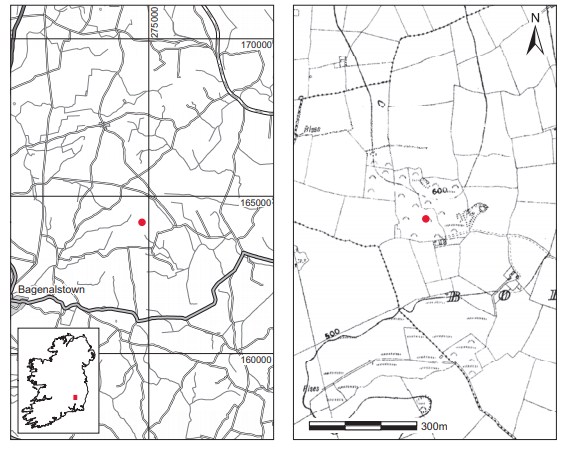County: Carlow Site name: BOHERDUFF, CO. CARLOW
Sites and Monuments Record No.: SMR CW016-016 Licence number: E1032
Author: ELLEN PRENDERGAST
Site type: Early Bronze Age graves
Period/Dating: —
ITM: E 674724m, N 664211m
Latitude, Longitude (decimal degrees): 52.723838, -6.893820
Introduction
In early February 1956 a short cist containing an inhumation burial was discovered on a farm near Muinebheag, Co. Carlow. The exact circumstances have not been noted but the capstone was presumably discovered first, and human bones were noticed within the cist11. The farmer, Thomas Gorman, kept the cist intact until it was inspected. The find was reported to the NMI by Inspector Poole of Muinebheag Garda Station. The cist was excavated by Ellen Prendergast on 3 March 1956. As there is no site report on file, this report is based on Prendergast’s plan and section of the cist, other correspondence on file and Professor C.A. Erskine’s anatomical report.

Location (Fig. 3.1)
The site is in the townland of Boherduff, west Co. Carlow, close to the border with County Kilkenny12. On the second edition OS map a quarry is marked in the adjoining field. The site lies between c. 150m and 180m above sea level. No sites of similar date are known from the immediate vicinity but the archaeological inventory for County Carlow lists a rectangular enclosure in this townland, some three fields south of the cist (Brindley and Kilfeather 1993, 82).
Description of site
The cist was rectangular in plan, with the long axis aligned east/west. Internally it measured 0.56m long by 0.38m wide by 0.33m high. It was composed of four principal slabs set on edge, with each one forming a side of the cist. The side slabs appear to be regular in shape, with a maximum thickness of 0.12m, maximum height of 0.34m and maximum length of 0.64m. Outside the main stones were four smaller stones, 0.09m by 0.07m in maximum dimensions, placed roughly at each corner (Fig. 3.2). The capstone appears to have been substantial in size, extending beyond the cist walls on the south, west and east sides. It measured 0.9m long by 0.79m wide by 0.16m thick. The floor of the cist does not appear to have been paved. The plan and section of the cist do not make any reference to a pit dug to receive the cist. The cist contained an articulated crouched inhumation of an infant and no accompanying artefacts were found. The crouched skeleton occupied the western half of the cist. It lay on its right side with the skull towards the centre of the north wall of the cist, its back to the east wall and the feet close to the west wall. The legs and arms were both flexed, with the elbows almost resting on the femora. The bones represented the remains of one infant (1956:11). Almost all parts of the skeleton were represented, although some of the bone was fragmentary. Based on the condition of the teeth, the skeleton was aged approximately 21 ⁄2 years. It could not be sexed, nor could the cause of death be determined.

Comment
The discovery of a single burial of an infant in a cist is highly unusual. In the absence of any accompanying pottery, the site has been included as an early Bronze Age cist based on the form of the grave. The human remains have not been dated.
HUMAN REMAINS
C.A. ERSKINE
The bones examined (1956:11) are those of one infant only. Nearly all the skeleton is represented, although no bone is quite complete and many are fragmentary. One of the skull fragments includes parts of both frontal bones and shows the lower part of the interfrontal (metopic) suture to be ossified; normal ossification in this suture does not begin until two years and is not complete until six to eight years. The mandible is well preserved and nearly complete; only fragments of the maxilla (superior maxilla) are present. Ten teeth, comprising the central incisor, canine and milk molars, are present and are well preserved. The stage of calcification of these teeth enable the age to be fixed at approximately two and a half years. The remainder of the bones more or less confirm this estimate. No opinion can be given as to the sex of the infant. There is no evidence of cremation. The cause of death cannot be determined from examination of the bones.
11. The depth below ground level at which the cist was discovered is not stated.
12. Parish of Dunleckny, barony of Idrone East. SMR CW016-016——. IGR 274790, 164170.